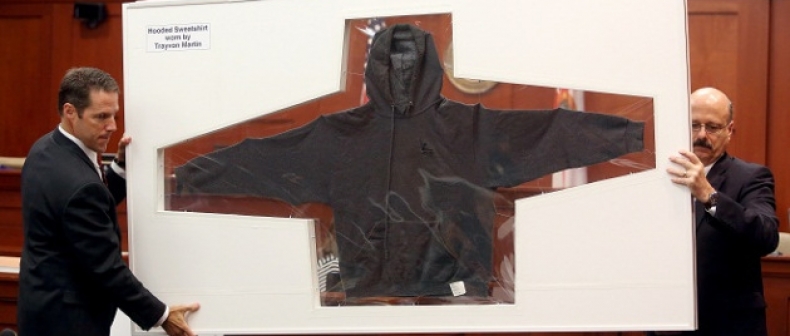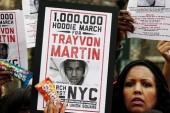
It’s deceptively simple for such a famous item. The hooded sweatshirt Trayvon Martin wore on the night he was shot by George Zimmerman is dark grey and boxy. It was made by Fruit of the Loom. The bullet hole is above the left breast. During the trial, it was presented to the court behind glass, with outstretched arms like a crucifix.
Now that Zimmerman has been found not guilty due to Florida’s “Stand Your Ground” laws, the sweater’s next destination is shrouded in mystery. It will be offered to Martin’s parents. If they decline to keep it, the hoodie could be locked away in a vast government storage facility. Or it could end up on display at a museum.
Lonnie Bunch, director of the Smithsonian’s National Museum of African American History and Culture, set to open in Washington in 2015, has expressed interest in acquiring it. He told the Washington Post the hoodie is uniquely positioned to encourage discussions on race.
“It’s rare that you get one artifact that really becomes the symbol,” he said. “Because it’s such a symbol, it would allow you to talk about race in the age of Obama.”
You hear ‘Smithsonian’ and you think of quirky bits of Americana like Dorothy’s Ruby Slippers and Jerry Seinfeld’s puffy shirt. But the collection at the National Museum of African American History and Culture will be appropriately somber–Bunch has already acquired the handcuffs used on Henry Louis Gates Jr., the professor arrested for entering his own home in 2009. Exhibits will be dedicated to topics like slavery, the era of Reconstruction, and the Civil Rights Movement.
To understand how a pedestrian garment like a hoodie might end up on the National Mall, canonized as part of Black history in the most official way imaginable, you have to consider history of hoodies. Although hooded capes go back to the Medieval period (the word ‘cappucino’ comes from the capuchin monks whose red-brown hoods resembled espresso mixed with milk), the modern hoodie dates back only to the 1930’s when the sportswear company Champion intended them for workmen. From there, they moved to athletes and eventually the streets.
The generation of African American men who came of age during the 1970’s, when ‘white flight’ left urban centres derelict and forgotten, created three cultural practices whose influence spread around the world–graffiti, rap music, and hoodies worn for style. Through rap hoodies followed white people to the suburbs and into the closets of teenagers everywhere.
But just as the popularity of rap, hip hop, and R&B hasn’t ended racism, hoodies never lost their illegal connotations. They’re ubiquitous (worn by children, yoga moms, and Mark Zuckerbeg), but in certain contexts still intimidate. We can only theorize about how large a role Trayvon Martin’s hoodie played in George Zimmerman’s decision to follow him that night. During the trial, Martin’s choice of clothing was analyzed and criticized, as though dressing like a ‘thug’ was a crime in and of itself. Geraldo Rivera claimed the hoodie was as much to blame for Martin’s death as Zimmerman.
“He didn’t profile Trayvon Martin because he was black,” he said recently. “He profiled him because he was wearing a hoodie.” To show solidarity with Martin, protestors donned the sweatshirts for the ‘Million Hoodie March,’ lawmakers wore them in Congress, and illustrator Nikkolas Smith imagined Martin Luther King Jr. peering out from a hoodie, symbolically linking them to the Civil Rights Movement.
The controversy isn’t about hoodies. It’s about race and the fear some have of people they see on the street. Neither banning hoodies totally nor encouraging everyone to wear one will erase the systemic problems that created the context of Martin’s murder. But, as Bunch argued, the hoodie is a symbol and symbols make it easier to talk about complex things.
Still, I can’t shake the feeling that it’s too soon to put Martin’s shirt behind glass. The case was a personal tragedy before it became a national one, and Martin’s parents are still grieving. They have the right to at least attempt to determine how their son is remembered.
At the same time, it’s undeniable the story now belongs to the ages. It was the most divisive court case of the last decade. Even though the trial is over, conflicting passions linger on. It seems strange that an object of such simmering attention could already be put in a museum. When you place an artifact behind glass you create distance between the object and the viewer, figuratively as well as literally. An Egyptian mummy or an Aztec crown, objects from long ago and far away, are divorced from our everyday lives.
But the Smithsonian’s African American Museum will be different. The legacy of the collection’s items, like the stocks and chains Africans wore when slave ships brought them to America, continue to be felt today. Displaying Martin’s hoodie on the National Mall, visited by tourists from across the country and the world, would guarantee controversy. Visitors may get into confrontations right in front of it. But Bunch would probably argue that there’s no point of a museum dedicated to the African American experience if it avoided these difficult conversations.
Despite President Obama’s two terms, an item like Trayvon Martin’s hoodie is a reminder that a post-racial America is still a far cry from reality.
____
Max Mosher writes about style for Toronto Standard. You can follow him on Twitter at @max_mosher_.
For more, follow us on Twitter @TorontoStandard or subscribe to our newsletter.














